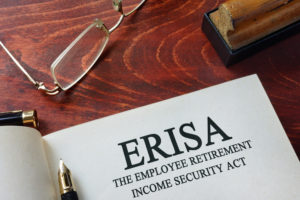
By Jason D. Lazarus, J.D., LL.M., CSSC, MSCC
For clients who are Medicaid, they will most likely have a Medicaid lien when their case is settled. Every state must comply with federal Medicaid statutes and regulations to participate in the joint federal-state Medicaid program. Pursuant to Title XIX of the Social Security Act, the federal Medicaid program requires every participating State to enact a “third party liability” provision which empowers a State to seek reimbursement from liable third parties for injury related medical expenditures paid on behalf of a Medicaid recipient.[1] In order to comply with this requirement, a State Medicaid program must have statutory provisions under which the Medicaid recipient is considered to have assigned to the State his or her right to recover from liable third parties medical expenses paid by Medicaid. Federal law codifies this stating[2]:
(H) that to the extent that payment has been made under the State Plan for medical assistance in any case where a third party has a legal liability to make payment for such assistance, the State has in effect laws under which, to the extent that payment has been made under the State Plan for medical assistance for health care items or services furnished to an individual, the State is considered to have acquired the rights of such individual to payment by any other party for such health care items or services.
Despite the mandate in federal law for state Medicaid agencies to seek reimbursement from liable third parties by “acquiring the rights of such individual to payment by any other party for such health care items or services,” there are important limitations on a State’s recovery rights which protect the Medicaid recipient’s property. The limitation comes from the federal anti-lien statute which proclaims “[n]o lien may be imposed against the property of any individual prior to his death on account of medical assistance paid,” and the federal anti-recovery statute at §1396p(b)(1) states “[n]o adjustment or recovery of any medical assistance correctly paid on behalf of an individual under the State plan may be made.”[3]
The tension between these provisions in federal law and state law recovery statutes has become the source of litigation in federal as well as State courts. When these cases reached the top court in the land, the Supreme Court held that federal provisions preempt and limit a State’s right to seek reimbursement from a Medicaid recipient’s settlement to the extent that it reaches elements of damages beyond past medical expenses. The United States Supreme Court first weighed in on the rights of a State Medicaid agency to recover from personal injury settlements via State third party liability recovery statutes in 2006. The Supreme Court’s decision in Arkansas Department of Health and Human Services v. Heidi Ahlborn[4] limited a State Medicaid program’s ability to assert a lien against the entire recovery from a third party tortfeasor. The United States Supreme Court interpreted federal law authorizing States to recover Medicaid payments in a tort action to be limited to medical payments.[5] Stated a different way, the Ahlborn decision forbids recovery by Medicaid state agencies against the non-medical portion of the settlement or judgment.[6] Non-medical portions of a settlement or judgment are damages such as pain and suffering or lost wages. According to the Court in Ahlborn:
. . . [t]here is no question that the State can require an assignment of the right, or chose in action, to receive payments for medical care. So much is expressly provided for by §§1396a(a)(25) and 1396k(a). And we assume, as do the parties, that the State can also demand as a condition of Medicaid eligibility that the recipient “assign” in advance any payments that may constitute reimbursement for medical costs. To the extent that the forced assignment is expressly authorized by the terms of §§1396a(a)(25) and 1396k(a), it is an exception to the anti‑lien provision. See Washington State Dept. of Social and Health Servs. v. Guardianship Estate of Keffeler, 537 U. S. 371, 383–385, and n. 7 (2003). But that does not mean that the State can force an assignment of, or place a lien on, any other portion of Ahlborn’s property. As explained above, the exception carved out by §§1396a(a)(25) and 1396k(a) is limited to payments for medical care. Beyond that, the anti‑lien provision applies.[7]
The holding of Ahlborn was a surprising result and has had a significant impact on personal injury litigation. In some instances, it has resulted in a much larger net amount being available to the injury victim at the “expense of the States’ ability to recover Medicaid expenditures.”[8]
When the Ahlborn decision was published, it was hailed by the Center for Constitutional Litigation (hereinafter “CCL”), associated with the American Trial Lawyers Association (now “American Association for Justice”), as a “significant victory” for injury victims.[9] Other commentators have agreed with the CCL that it represents a major victory for injury victims.[10] State courts, have limited its application in some instances or found it wholly inapplicable.
Ahlborn by the Facts
Heidi Ahlborn was injured in a very serious car accident in January of 1996.[11] At the time, she was a nineteen year old college student pursuing a degree in teaching.[12] She suffered a catastrophic brain injury that left her incapable of finishing college and unable to care for or support herself in the future.[13] Due to her injuries and lack of assets, Ahlborn qualified for Medicaid coverage in Arkansas.[14] Medicaid paid Arkansas healthcare providers $215,645.30 for injury related care on her behalf.[15]
After the accident, a personal injury action was filed on behalf of Heidi in April of 1997.[16] The damages sought included not only past medical costs but also for her “permanent physical injury; future medical expenses, past and future pain, suffering and mental anguish; past loss of earnings and working time; and permanent impairment of the ability to earn in the future.”[17] During the pendency of the litigation, the Arkansas Department of Health Services (hereinafter “ADHS”) sent Ahlborn’s personal injury attorneys periodic notices regarding the outlays by Medicaid on behalf of Ms. Ahlborn.[18] The letters indicated that Arkansas law provided ADHS with a claim for reimbursement from “any settlement, judgment or award” that was obtained from “a third party who may be liable” for Heidi Ahlborn’s injuries and no settlement “shall be satisfied without first giving [ADHS] notice and a reasonable opportunity to establish its interest.”[19]
When suit was filed, ADHS wasn’t notified of the suit, as requested. Plaintiff’s counsel did inform ADHS of the available insurance coverage in the suit. [20] ADHS intervened in the personal injury action in February of 1998 to assert a lien against any proceeds from a settlement or judgment.[21] The case was ultimately settled in 2002 without, per customary practice, any allocation of the settlement proceeds between categories of damages.[22] ADHS asserted a lien against the settlement for the total amount of the payments made by ADHS for Ahlborn’s care which totaled $215,645.30.[23]
In September of 2002, Ahlborn filed suit in the United States District Court for the Eastern District of Arkansas seeking a declaratory judgment that “the lien violated the federal Medicaid laws insofar as its satisfaction would require depletion of compensation for injuries other than past medical expenses.”[24] Certain stipulations were entered into by the parties in the litigation in the US District Court. Firstly, ADHS and Ahlborn stipulated that Heidi Ahlborn’s total claim “was reasonably valued at $3,040,708.18.”[25] Secondly, the parties agreed that the out of court settlement reached represented “one-sixth of that sum.”[26] Thirdly, the parties stipulated that if the plaintiff’s “construction of federal law was correct, ADHS would be entitled to only the portion of the settlement ($35,581.47) that constituted reimbursement for medical payments made.”[27]
On cross motions for summary judgment, the Federal District Court found that Ahlborn, under Arkansas law, assigned to ADHS her right to any tort recovery from third parties to the “full extent of Medicaid’s payments for her benefit.”[28] The Court held accordingly that ADHS was entitled to its full lien amount of $215,645.30.[29] The ruling was appealed to the Eighth Circuit and the judgment of the District Court was reversed.[30] The Eighth Circuit held that ADHS was only entitled to the portion of the settlement attributable to payments for medical care.[31] ADHS appealed to the United States Supreme Court which affirmed the Eighth Circuit’s decision.[32]
The heart of the controversy before the Supreme Court was the interpretation of federal law requiring state Medicaid programs to recover from third party tortfeasors amounts paid on behalf of an injury victim.[33] State Medicaid agencies must “take all reasonable measures to ascertain the legal liability of third parties . . . . to pay for care and services available under the plan.”[34] Federal law also requires state Medicaid agencies to seek recovery from third parties where the reimbursement the State will receive exceeds the costs of recovery.[35] States are required to enact State statutes to facilitate recovery of such claims by providing an assignment from the injury victim to the State Medicaid agency for recovery of third party medical care payments.[36] Finally, the amount collected by the State Medicaid agency “shall be retained by the State as is necessary to reimburse it for medical assistance payments made on behalf of” the Medicaid recipient.[37]
Arkansas had complied with federal law and enacted statutes providing ADHS with the right to recover “the cost of benefits” from third parties.[38] Arkansas law provided that as a “condition of eligibility”, Medicaid applicants “shall automatically assign his or her right to any settlement, judgment or award which may be obtained against any third party to [ADHS] to the full extent of any amount which may be paid by Medicaid for the benefit of the applicant.”[39] Further, the Arkansas statute provided that ADHS “shall have a right to recover” when medical assistance is provided to the Medicaid recipient due to “injury, disease, or disability for which another person is liable.”[40] It was pursuant to this statute that the ADHS claimed an entitlement to recover all of the costs expended on Ahlborn’s behalf even though it would be recovered from portions of a settlement that didn’t represent medical expenses.[41]
The question squarely before the United States Supreme Court was whether the ADHS could “lay claim to more than the portion of Ahlborn’s settlement that represents medical expenses.”[42] Justice Stevens said in the opinion that the “text of the federal third-party liability provisions suggests not; it focuses on recovery of payments for medical care.”[43] While the State of Arkansas made many legal arguments to the Supreme Court as to why ADHS’s lien attached to Ahlborn’s entire settlement, each was rejected by the Court. Arkansas’ primary legal argument was that the federal statute mandated every State to pass laws that require the assignment of a Medicaid beneficiary’s rights to the State and assertion of liens to collect from the entire third-party recovery.[44] Justice Stevens addressed this argument by pointing to federal law which says the “State must be assigned ‘the rights of [the recipient] to payment by any other part for such health care items or services.’”[45] According to the Court, federal law didn’t sanction “an assignment of rights to payment for anything other than medical expenses –not lost wages, not pain and suffering, not an inheritance.”[46] This was not the basis of the Court’s decision in favor of Ahlborn though.
Instead, the Court’s decision rested on its interpretation of the “anti-lien”[47] statute in the United States Code.[48] The anti-lien statute prohibits States from exerting liens against a Medicaid recipient’s property prior to death for medical assistance paid on their behalf except in specifically enumerated situations.[49] While the Court found one of the anti-lien statute’s enumerated exceptions was relevant to Ahlborn’s situation, it was the assignment of a Medicaid beneficiary’s rights to the State and assertion of liens to collect from a third-party recovery which it found was limited only to medical care.[50] Accordingly, because the exception that was carved out was limited to payments for medical care, the anti-lien provision bars recovery by ADHS against the portion of Ahlborn’s settlement that was non-medical.[51]
Arkansas made several public policy arguments as to why a rule of full reimbursement was needed. The most “colorable” argument was that there was an “inherent danger of manipulation in cases where the parties to a tort case settle without judicial oversight or input from the State.”[52] The Court found that this issue was not before them because the ADHS had stipulated that only $35,581.47 of Ahlborn’s settlement proceeds were attributable to payment for medical costs.[53] Nevertheless, Justice Stevens pointed out that “[e]ven in the absence of such a post-settlement agreement, though, the risk that parties to a tort suit will allocate away the State’s interest can be avoided either by obtaining the State’s advance agreement to an allocation or, if necessary by submitting the matter to a court for decision.”[54] He went on to say “just as there are risks in underestimating the value of readily calculable damages in settlement negotiations, so also is there a countervailing concern that a rule of absolute priority might preclude settlement in a large number of cases, and be unfair to the recipient in others.”[55]
Since the primary holding in Ahlborn is that federal laws that authorize States to assert recoveries against third parties who have provided payments for medical care for Medicaid beneficiaries only applies to the portions of a settlement that represent compensation for past medical expenses, it appeared to invalidate state statutes that require full reimbursement of Medicaid expenditures from a third party recovery. After the Ahlborn decision, States began to revise their third-party liability statutes with inconsistent results in the courts. In 2012, a challenge of the North Carolina Medicaid’s third-party liability recovery statute would lead the United States Supreme Court to again weigh in on state Medicaid agencies rights to recover.
In E.M.A. v. Cansler[56], the Fourth Circuit Court of Appeal agreed with the Third Circuit that in determining what portion of a Medicaid beneficiary’s third-party recovery a State Medicaid agency may claim as reimbursement for Medicaid expenses, the state must have in place procedures that allow a dissatisfied beneficiary to challenge a statutory default allocation. In reaching its conclusion, the Fourth Circuit also held that the North Carolina Supreme Court wrongly interpreted Ahlborn in upholding the validity of North Carolina’s statutory default allocation in a previous decision.
According to the E.M.A. decision, the United State Supreme Court’s unanimous decision in Ahlborn makes clear, “federal Medicaid law limits a state’s recovery to settlement proceeds that are shown to be properly allocable to past medical expenses. In the event of an unallocated lump-sum settlement exceeding the amount of the state’s Medicaid expenditures, as in this case, the sum certain allocable to medical expenses must be determined by way of a fair and impartial adversarial procedure that affords the Medicaid beneficiary an opportunity to rebut the statutory presumption in favor of the state that allocation of one-third of a lump sum settlement is consistent with the anti-lien provision in federal law.”[57]
The Fourth Circuit went on to say “The Supreme Court has characterized the third-party liability provisions in federal Medicaid law as an exception to the anti-lien provisions, stating that “[t]o the extent that the forced assignment [of payments that constitute reimbursement for medical expenses] is expressly authorized in §§ 1396a(a)(25) and 1396k(a), it is an exception to the anti-lien provision.” Ahlborn, 547 U.S. at 284, 126 S.Ct. 1752 (citing Wash. State Dep’t of Soc. & Health Servs. v. Guardianship Estate of Keffeler, 537 U.S. 371, 383-85, & n. 7, 123 S.Ct. 1017, 154 L.Ed.2d 972 (2003)). At the same time, the Supreme Court has emphasized that this exception is strictly limited—a State cannot force assignment of, or place a lien on, any property that does not constitute reimbursement for medical expenses. Id. at 284-85, 126 S.Ct. 1752 (“[T]he exception carved out by §§ 1396a(a)(25) and 1396k(a) is limited to payments for medical care. Beyond that, the anti-lien provision applies.”).”
The Fourth Circuit did not agree with North Carolina’s argument that its statute set a “reasonable cap” on the State’s recovery and therefore satisfied the federal anti-lien law.[58] Instead, the court concluded that North Carolina’s one-third cap on a Medicaid recipient’s settlement proceeds does not satisfy Ahlborn insofar as it permits North Carolina to assert a lien against settlement proceeds intended to compensate the Medicaid recipient for other claims, such as pain and suffering or lost wages.[59] The court declined to express a view as to whether allocation disputes must be adjudicated by a court, or may instead be resolved through other “special rules and procedures” alluded to in Ahlborn. However, the court held that in determining what portion of a Medicaid beneficiary’s third-party recovery the State may claim in reimbursement for Medicaid expenses, it must have in place procedures that allow a dissatisfied beneficiary to challenge the default allocation.[60] As the North Carolina statute had no such provision, the court remanded the case back to the district court to make the allocation.
The United States Supreme Court granted Certiorari on September 25, 2012. Oral arguments occurred on January 8, 2013. The Court rendered its opinion on March 20, 2013 upholding the Fourth Circuit’s judgment in a 6-3 decision.[61] In WOS v. EMA, the Supreme Court was asked to review North Carolina’s Medicaid Third Party Liability Recovery statute. North Carolina’s statute required that up to one-third of any damages recovered by a beneficiary for their injuries must be paid to Medicaid to reimburse it for payments it made on account of the injury. The Supreme Court found that this statute was not compatible with the federal anti-lien provision and violated the holding of Ahlborn which “precludes attachment or encumbrance” of any portion of a settlement not “designated as payments for medical care”.[62]
The Wos decision discussed the tension between the mandate under federal law requiring an assignment to the State of “the right to recover that portion of a settlement that represents payments for medical care,” and the preclusion of “attachment or encumbrance of the remainder of the settlement.” The Ahlborn opinion held that the federal Medicaid statute sets both a floor and a ceiling on a State’s potential share of a beneficiary’s tort recovery. The Wos court pointed out that an injury victim has a property right in the proceeds of a settlement “bringing it within the ambit of the anti-lien provision.”[63] “That property right is subject to the specific statutory “exception” requiring a State to seek reimbursement for medical expenses paid on the beneficiary’s behalf, but the anti-lien provision protects the beneficiary’s interest in the remainder of the settlement.”[64]
North Carolina’s statute as applied ran afoul of the holding in Ahlborn because it set “forth no process for determining what portion of a beneficiary’s tort recovery is attributable to medical expenses.” Instead, the statute applies an arbitrary figure (one-third) and mandates that amount be the payment for medical care out of the tort recovery. As applied, this violates the federal anti-lien law and is therefore pre-empted. The Wos Court pointed out that if “a State arbitrarily may designate one-third of any recovery as payment for medical expenses, there is no logical reason why it could not designate half, three-quarters, or all of a tort recovery in the same way.”[65] Since North Carolina could provide no evidence to substantiate the claim it made that the one-third allocation was reasonable and provided no mechanism for determining whether it was a reasonable approximation in any particular case, the Court rejected its application.
In a very important part of the decision, the Wos Court discusses when the state may not demand recovery from a portion of the settlement allocated to non-medical damages. The court stated that when “there has been a judicial finding or approval of an allocation between medical and nonmedical damages—in the form of either a jury verdict, court decree, or stipulation binding on all parties—that is the end of the matter.”[66] “With a stipulation or judgment under this procedure, the anti-lien provision protects from state demand the portion of a beneficiary’s tort recovery that the stipulation or judgment does not attribute to medical expenses.”[67]
In applying all of the foregoing to the facts of the case, the Wos Court pointed out the flaws of the North Carolina statute which didn’t allow for an allocation. The Court found that a substantial share of the damages in the settlement must be allocated to skilled home care in the future. This would not be reachable by the state Medicaid agency to satisfy their lien. In addition, the Wos Court noted that it may also be necessary to consider how much EMA and her parents could have expected to receive in terms of compensation for the other tort claims made in the suit had it gone to trial. “An irrebuttable, one-size-fits-all statutory presumption is incompatible with the Medicaid Act’s clear mandate that a State may not demand any portion of a beneficiary’s tort recovery except the share that is attributable to medical expenses.”[68]
As a trial lawyer, it is important to understand the underpinnings of the Ahlborn and Wos decisions so you can apply them to your State’s third-party liability recovery provisions. The important thing to remember is that these cases limit a State Medicaid agency’s recovery rights related to a third-party liability settlement. In order to reduce a Medicaid lien, State specific statutes must be followed, but arguments to reduce should be based on the principles espoused in Ahlborn and Wos so that the lien is reduced in proportion to the full value of damages versus what was received.
[1] See 42 U.S.C. §1396a(a)(25).
[2] 42 U.S.C. §1396a(a)(25)(H).
[3] 42 U.S.C. §1396p(a)(1)
[4] 547 U.S. 268 (2006).
[5] See Ahlborn 547 U.S. at 290.
[6] Id.
[7] Id. at 284.
[8] Joseph D. Juenger, In Light of Ahlborn – Designing State Legislation to Protect the Recovery of Medicaid Expenses from Personal Injury Settlements, 35 N. Ky. L. Rev. 103 (2008).
[9] Lou Bograd, Center for Constitutional Litigation, P.C., Memorandum to Interested Parties, Possible Extension of Ahlborn Ruling to Medicare and Guidance to Plaintiff’s Counsel Regarding the Decision (May 16, 2006).
[10] Juenger, supra note 6 at 103.
[11] Ahlborn, 547 U.S. at 273.
[12] Id.
[13] Id.
[14] Id.
[15] Id.
[16] Id.
[17] Id.
[18] Id. at 274.
[19] Id.
[20] Id.
[21] Id.
[22] Id.
[23] Id.
[24] Id.
[25] Id.
[26] Id.
[27] Id.
[28] Id.
[29] Id.
[30] Id. at 275.
[31] Id.
[32] Id.
[33] Id.
[34] Id. (quoting 42 U.S.C. §1396a(a)(25)(A)).
[35] 42 U.S.C. §1396a(a)(25)(B).
[36] 42 U.S.C. §1396a(a)(25)(H); see also 42 U.S.C. §1396k(a).
[37] 42 U.S.C. §1396k(a).
[38]Ahlborn 547 U.S. at 277 (citing Ark. Code Ann. §§20-77-301 through 20-77-309 (2001)).
[39] Id. at 277.
[40] Id.
[41] Id. at 278.
[42] Id. at 280.
[43] Id.
[44] Id. at 281.
[45] Id.
[46] Id.
[47] 42 U.S.C. §1396p
[48] Ahlborn, 547 U.S. at 284.
[49] Id.
[50] Id.
[51] Id.
[52] Id. at 288.
[53] Id.
[54] Id.
[55] Id.
[56] 674 F.3d 290 (4th Cir. 2012), cert. granted sub nom. Delia v. E.M.A., 567 U.S. ___ (Sept. 25, 2012)
[57] Id. at 312 (emphasis added)
[58] Id. at 308.
[59] Id. at 307.
[60] Id. at 311.
[61] WOS v. E.M.A., 133 S. CT. 1391, 185 L. Ed. 2d 471(2013).
[62] Id.
[63] Id.
[64] Id.
[65] Id.
[66] Id.
[67] Id.
[68] Id.

Jason D. Lazarus is the managing partner and founder of the Special Needs Law Firm; a Florida law firm that provides legal services related to public benefit preservation, liens and Medicare Secondary Payer compliance. He is also the founder and Chief Executive Officer of Synergy Settlement Services, which offers healthcare lien resolution, Medicare secondary payer compliance services, public benefit preservation and complex settlement consulting.











Comments for this article are closed.